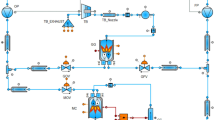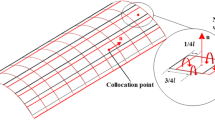Abstract
There has been an increased focus on using gasoline direct injection engines operating at the stoichiometric point due to their potential to improve fuel economy. Nonetheless, particulate matter emitted by gasoline vehicles negatively affect human health. Gasoline particulate filters are the most promising technology in the reduction of particulate matter emissions along with fuel efficiency. Depending on the particle’s size, its deposition and trajectory highly depend on flow pattern; however, the flow regime within gasoline particulate filters is still yet to be solved. The present investigation uses a representation of a gasoline particulate filter to demonstrate the effects of turbulence in the flow behaviour therein. These effects are analysed utilising different Reynolds-average-Navier-Stokes models and the laminar model with inflow velocities and filter wall permeability. The results demonstrate that turbulence significantly modifies flow pattern within the channels and porous wall as well as the pressure drop.







Similar content being viewed by others
Abbreviations
- D c :
-
channel height, m
- H :
-
domain height, m
- k :
-
turbulent kinetic energy, m2/s2
- L :
-
channel length, m
- P :
-
pressure, Pa
- P stat :
-
static pressure, Pa
- \(S_{U_i}\) :
-
momentum source term, Pa/m
- U c :
-
average velocity at the entrance of the inlet channel, m/s
- U f :
-
velocity of the total flow fraction, m/s
- U i :
-
velocity vector, m/s
- U m :
-
velocity magnitude, m/s
- U in :
-
upstream inlet velocity, m/s
- P∗ :
-
dimensionless pressure (=P/(\(\frac {1}{2}\rho U^2))\)
- Re:
-
Reynolds number
- Rec :
-
channel Re number (=ρUcDc/μ)
- Re𝜃t :
-
Reynolds momentum thickness
- α :
-
permeability, m2
- γ :
-
intermittency
- μ :
-
viscosity, Pa-s
- ω :
-
specific dissipation rate, 1/s
- ρ :
-
density, kg/m3
- CFD:
-
computer fluid dynamics
- DPF:
-
diesel particulate filter
- GDI:
-
gasoline direct injection
- GPF:
-
gasoline particulate filter
- PM:
-
particulate matter
- RANS:
-
Reynolds-average-Navier-Stokes
- SIMPLE:
-
semi-implicit method for pressure linked equations
- SST:
-
shear stress transport
- TI:
-
turbulence intensity
- TVR:
-
turbulent viscosity ratio
- TWC:
-
three-way catalyst
References
Svetlana, A., Saul, J., Medina, H., Garcia-Afonso, O., Lin, C., Herreros, J.M., Bevan, M., Benjamin, S.F.: Gasoline particulate filter wall permeability testing. SAE Int. J. Engines 11(03-11-05-0039), 571–584 (2018)
ANSYS Fluent Ansys: 18.2 Theory Guide. ANSYS inc 390, 1 (2017)
Beavers, G.S., Joseph, D.D.: Boundary conditions at a naturally permeable wall. J. Fluid Mech. 30(1), 197–207 (1967)
Gordon, S.B., Ephraim, M.S., Magnuson, R.A.: Experiments on coupled parallel flows in a channel and a bounding porous medium. J. Basic Eng. 92(4), 843–848 (1970)
Beavers, G.S., Sparrow, E.M., Masha, B.A.: Boundary condition at a porous surface which bounds a fluid flow. AIChE J 20(3), 596–597 (1974)
Bensaid, S., Marchisio, D.L., Fino, D., Saracco, G., Specchia, V.: Modelling of diesel particulate filtration in wall-flow traps. Chem. Eng. J. 154(1-3), 211–218 (2009)
Carotenuto, C., Minale, M.: Shear flow over a porous layer: velocity in the real proximity of the interface via rheological tests. Phys. Fluids 23(6), 063101 (2011)
Cornejo, I., Hayes, R.E., Nikrityuk, R.E.: A new approach for the modeling of turbulent flows in automotive catalytic converters. Chem. Eng. Res. Design 140, 308–319 (2018)
Cornejo, I., Nikrityuk, P., Hayes, R.E.: Multiscale RANS-based modeling of the turbulence decay inside of an automotive catalytic converter. Chem. Eng. Sci. 175, 377–386 (2018)
Cornejo, I., Nikrityuk, P., Hayes, R.E.: Turbulence generation after a monolith in automotive catalytic converters. Chem. Eng. Sci. 187, 107–116 (2018)
Cornejo, I., Nikrityuk, P., Hayes, R.E.: Pressure correction for automotive catalytic converters: a multi-zone permeability approach. Chem. Eng. Res. Design (2019)
Deuschle, T., Janoske, U., Piesche, M.: A CFD-model describing filtration, regeneration and deposit rearrangement effects in gas filter systems. Chem. Eng. J. 135(1-2), 49–55 (2008)
Guan, B., Zhan, R., He, L., Huang, Z.: Review of the state-of-the-art of exhaust particulate filter technology in internal combustion engines. Journal of Environmental Management 154, 225–258 (2015)
Haralampous, O.A., Kandylas, I.P., Koltsakis, G.C., Samaras, Z.C.: Diesel particulate filter pressure drop part 1: modelling and experimental validation. Int. J. Engine Res. 5(2), 149–162 (2004)
Joshi, A., Johnson, T.V.: Gasoline particulate filters–a review. Emission Control Sci. Technol. 4(4), 219–239 (2018)
Lambert, C., Chanko, T., Dobson, D., Liu, X., Pakko, J.: Gasoline particle filter development. Emission Control Sci. Technol. 3(1), 105–111 (2017)
Mamakos, A., Martini, G., Dilara, P., Drossinos, Y.: Feasibility of introducing particulate filters on gasoline direct injection vehicles. A cost benefit analysis. European Commission Joint Research Center (2011)
Mamakos, A., Steininger, N., Martini, G., Dilara, P., Drossinos, Y.: Cost effectiveness of particulate filter installation on direct injection gasoline vehicles. Atmos. Environ. 77, 16–23 (2013)
Morgan, C.: Platinum group metal and washcoat chemistry effects on coated gasoline particulate filter design. Johnson Matthey Technology Review 59(3), 188–192 (2015)
Piscaglia, F., Rutland, C.J., Foster, D.E.: Development of a CFD model to study the hydrodynamic characteristics and the soot deposition mechanism on the porous wall of a diesel particulate filter. Technical report, SAE Technical Paper 2005-01-0963 (2005)
Sahraoui, M., Kaviany, M.: Slip and no-slip velocity boundary conditions at interface of porous, plain media. Int. J. Heat Mass Transf. 35(4), 927–943 (1992)
Ström, H., Andersson, B.: Simulations of trapping of diesel and gasoline particulate matter in flow-through devices. Topics in Catalysis 52(13), 2047–2051 (2009)
Ström, H., Sasic, S., Andersson, B.: Effects of the turbulent-to-laminar transition in monolithic reactors for automotive pollution control. Indust. Eng. Chem. Res. 50(6), 3194–3205 (2011)
Ileana, M., Mesquida, V.: Analysis of flow pattern in a gasoline particulate filter using CFD. Master’s thesis, University of Alberta (2019)
Vrentas, J.S., Duda, J.L.: Flow of a Newtonian fluid through a sudden contraction. Appl. Sci. Res. 28(1), 241–260 (1973)
Wang, H., Wang, Y.: Flow in microchannels with rough walls: flow pattern and pressure drop. J. Micromech. Microeng. 17(3), 586 (2007)
Wang, Y.L., Longwell, P.A.: Laminar flow in the inlet section of parallel plates. AIChE J 10(3), 323–329 (1964)
Mengting, Y., Luss, D., Balakotaiah, V.: Regeneration modes and peak temperatures in a diesel particulate filter. Chem. Eng. J. 232, 541–554 (2013)
Acknowledgements
Vega Mesquida acknowledges additional support from the Dean of the Faculty of Engineering at the University of Alberta, Dr. Forbes. I. Cornejo acknowledges the receipt of a Becas-Chile (CONICYT) scholarship.
Funding
This study is financially supported by the Natural Science and Engineering Research Council of Canada. I. This research was enabled in part by support provided by Compute Ontario (computeontario.ca) and Compute Canada (www.computecanada.ca).
Author information
Authors and Affiliations
Corresponding author
Ethics declarations
Conflict of interest
The authors declare that they have no competing interests.
Additional information
Publisher’s Note
Springer Nature remains neutral with regard to jurisdictional claims in published maps and institutional affiliations.
Rights and permissions
About this article
Cite this article
Mesquida, I.M.V., Cornejo, I., Nikrityuk, P. et al. Simulation of Flow Patterns in Particulate Filters with Various Viscous Models. Emiss. Control Sci. Technol. 6, 178–185 (2020). https://doi.org/10.1007/s40825-020-00158-y
Received:
Revised:
Accepted:
Published:
Issue Date:
DOI: https://doi.org/10.1007/s40825-020-00158-y




